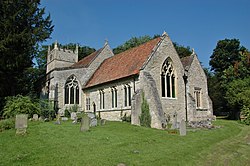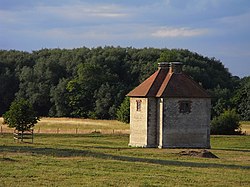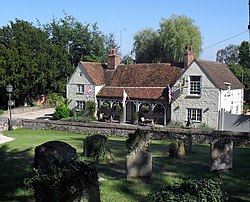Difference between revisions of "Brightwell Baldwin"
(Created page with "{{infobox town |county=Oxford |picture=BrightwellBaldwin StBartholomew SE.jpg |picture caption= St Bartholomew's parish church |latitude=51.651 |longitude=-1.058 |os grid ref=...") |
(No difference)
|
Revision as of 10:20, 23 February 2021
| Brightwell Baldwin | |
| Oxfordshire | |
|---|---|
 St Bartholomew's parish church | |
| Location | |
| Grid reference: | SU6595 |
| Location: | 51°39’4"N, 1°3’29"W |
| Data | |
| Population: | 208 (2011) |
| Post town: | Watlington |
| Postcode: | OX49 |
| Local Government | |
| Council: | South Oxfordshire |
| Parliamentary constituency: |
Henley |
| Website: | Parish Meeting |
Brightwell Baldwin is a village and parish in Oxfordshire, about 4½ miles north-east of Wallingford in neighbouring Berkshire. The ancient parish forms part of Ewelme Hundred.[1] The 2011 Census recorded the civil parish's population as 208.[2]
The parish is roughly rectangular, about 2½ miles long north–south and about 1¼ miles wide east–west. In 1848 the parish was recorded as covering an area of 1,569 acres.[1]
The B4009 road linking Benson and Watlington forms part of the southern boundary of the parish. The B480 road linking Oxford and Watlington forms a small part of its northern boundary. Rumbolds Lane forms much of its western boundary. For the remainder the parish is bounded largely by field boundaries.
Contents
Toponym
"Brightwell" is derived from the Old English for "bright spring".[3] "Baldwin" is the name of a family that held the manor.
The earliest known record of Brightwell Baldwin is a Saxon charter of AD 854 in the Cartularium Saxonicum that records the topony] as Beorhtawille or Brihtanwylle. Almost a century later a Saxon charter of AD 945 records it as Byrhtanwellan. The Domesday Book of 1086 records it as Bretewelle.[3]
Brightwell Park
The old country house of the Stone family burnt down in 1786, but a cruciform 17th-century dovecote[4] that was some distance from the house survives in the park.[5]
In 1790 a replacement house was built.[1] It has since been demolished, but its kitchen wing, stables, ice house[6] and an 18th-century stone arch bridge[7] in the park survive.
Parish church
The earliest parts of the Church of England parish church of Saint Bartholomew are 13th-century, including a stair turret and a number of lancet windows, notably in the chancel.[8][9] Early in the 14th century the nave was rebuilt in the Decorated Gothic style, with north and south aisles linked to it by arcades of four bays.[8] The west tower and the Perpendicular Gothic east window of the chancel were added in the 15th century.[8] The pulpit and tester are Jacobean[8] and therefore 17th-century. The building was restored in 1895 and is a Grade-I listed.[9]
Church monuments in St Bartholomew's include a number of brasses. In the north aisle is a brass commemorating John the Smith, who died in 1371.[9] It bears an epitaph written in Middle English,[10] which may be the earliest example of an inscription in the English language.[11] The epitaph reflects upon human mortality:
man com & se how schal alle dede li: wen þow comes bad & bare
noth hab ven ve awaẏ fare: All ẏs wermēs þt ve for care:—
hunyr þis graue lẏs John ye smẏth god yif his soule heuen grit[10][11]
bot þt ve do for godẏs luf ve haue nothyng yare:
In the chancel are two brasses commemorating John Cottesmore, who died in 1439.[9] Stone monuments include two 16th-century chest tombs of members of the Carleton family, and a substantial English Baroque monument to members of the Stone family on the east wall of the north chapel.[8] The latter was built in about 1670[8] or 1690,[9] replacing monuments to John Stone (died 1640) and his son Sir Richard Stone (died 1660) that were destroyed in the Great Fire of London in 1666.[12]
The bell tower has a ring of six bells. John Saunders of Reading, Berkshire cast the tenor bell in about 1559.[13] Ellis I Knight, also of Reading, cast the fifth bell in 1637.[13] Mears and Stainbank of the Whitechapel Bell Foundry cast or recast the treble, second, third and fourth bells in 1911.[13] There is also a Sanctus bell that was cast in about 1550.[13]
The churchyard includes a late 18th-century chest tomb a number of 17th-century gravestones that are Grade-II listed.[14][15][16][17] Another 17th-century monument commemorates one Stephen Rumbold, who died in 1687 aged 105.[18] On it a rhyming epigram bets with its readers:
He liv'd one hundred and five
Sanguine and Strong
You do not live so long[18]
An hundred to five
St Bartholomew's parish is now part of the benefice of Ewelme, Brightwell Baldwin, Cuxham and Easington.[19]
Amenities
Brightwell Baldwin has a 17th-century pub, The Lord Nelson Inn.[20][21] It is now a gastropub.[22]
The Old Forge is a Grade-II-listed former blacksmiths shop: it was bought in 2002 by the Duke and Duchess of Kent.[23]
References
- ↑ 1.0 1.1 1.2 Lewis 1931, pp. 375–379.
- ↑ UK Census (2011). "Local Area Report – Brightwell Baldwin Parish (1170217773)". Nomis. Office for National Statistics. https://www.nomisweb.co.uk/sources/census_2011_ks/report?compare=1170217773. Retrieved 2 August 2018
- ↑ 3.0 3.1 In fact a simple corruption of the words: Bride's Well. The name of the ancient British goddess (Bridget or Bride). This shows the antiquity of the place. Ekwall 1960, Brightwell
- ↑ National Heritage List 1368825: Brightwell Park, dovecote approximately 220 metres north east of Brightwell Park (Grade II listing)
- ↑ Sherwood & Pevsner 1974, p. 485.
- ↑ National Heritage List 1059761: Brightwell Park, icehouse approximately 190 metres north north east of Brightwell Park (Grade II listing)
- ↑ National Heritage List 1059760: Brightwell Park, bridge and flanking walls approximately 290 metres east of Brightwell Park (Grade II listing)
- ↑ 8.0 8.1 8.2 8.3 8.4 8.5 Sherwood & Pevsner 1974, p. 484.
- ↑ 9.0 9.1 9.2 9.3 9.4 National Heritage List 1059763: Church of St Bartholomew (Grade I listing)
- ↑ 10.0 10.1 Bertram 2003, p. 30.
- ↑ 11.0 11.1 Utechin 1990, p. 39.
- ↑ Utechin 1990, p. 4.
- ↑ 13.0 13.1 13.2 13.3 Davies, Peter (11 May 2012). "Brightwell Baldwin S Bartholomew". Dove's Guide for Church Bell Ringers. Central Council of Church Bell Ringers. http://dove.cccbr.org.uk/detail.php?searchString=Brightwell+Baldwin&Submit=+Go+&DoveID=BRIGHTWE+B. Retrieved 6 August 2013.
- ↑ National Heritage List 1059764: Church of St Bartholomew, chest tomb approximately 1.7 metres east of south porch (Grade II listing)
- ↑ National Heritage List 1059765: Church of St Bartholomew, headstone approximately 13 metres south of south porch (Grade II listing)
- ↑ National Heritage List 1181623: Church of St Bartholomew, headstone approximately 3.5 metres south east of nave and 5 metres south of chancel (Grade II listing)
- ↑ National Heritage List 1181635: Church of St Bartholomew, group of 4 headstones approximately 5 metres south south west of south porch (Grade II listing)
- ↑ 18.0 18.1 Utechin 1990, p. 82.
- ↑ Archbishops' Council (2010). "Benefice of Ewelme Brightwell Baldwin Cuxham with Easington". A Church Near You. Church of England. http://www.achurchnearyou.com/benefice.php?B=27/181BH&V=46. Retrieved 6 August 2013.
- ↑ Sherwood & Pevsner 1974, p. 486.
- ↑ National Heritage List 1181675: The Lord Nelson Inn (Grade II listing)
- ↑ The Nelson
- ↑ "Brightwell Baldwin Pages 89-121 A History of the County of Oxford: Volume 18. Originally published by Boydell & Brewer for the Institute of Historical Research, Woodbridge, Suffolk, 2016.". https://www.british-history.ac.uk/vch/oxon/vol18/pp89-121.
Sources
- Bertram, Jerome (2003). "Medieval Inscriptions in Oxfordshire". Oxoniensia (Oxfordshire Architectural and Historical Society) LXVVIII: 27–54. SSN 0308-5562. http://oxoniensia.org/volumes/2003/bertram.pdf.
- Ekwall, Eilert (1960). Concise Oxford Dictionary of English Place-Names (4th ed.). Oxford: Oxford University Press. Brightwell. ISBN 0198691033.
- Lewis, Samuel, ed (1931). "Brightwell-Baldwin (St. Bartholomew)". A Topographical Dictionary of England (Seventh ed.). London: Samuel Lewis. pp. 375–379. https://www.british-history.ac.uk/topographical-dict/england/pp375-379#h3-0005.
- Sherwood, Jennifer; Pevsner, Nikolaus (1974). Oxfordshire. The Buildings of England. Harmondsworth: Penguin Books. pp. 484–486. ISBN 0-14-071045-0.
- Utechin, Patricia (1990). Epitaphs from Oxfordshire (2nd ed.). Oxford: Robert Dugdale. pp. 4, 39, 82. ISBN 0-946976-04-X.
Outside links
| ("Wikimedia Commons" has material about Brightwell Baldwin) |

